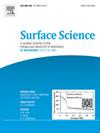氧和碳在W(100)表面共吸附的物理过程:溶解在体中的原子碳的影响
IF 1.8
4区 化学
Q3 CHEMISTRY, PHYSICAL
引用次数: 0
摘要
在W(100)表面原子氧和碳之间的相互作用被考虑在很宽的温度范围内(300 - 2000 K)和两种吸附剂的浓度。氧原子不溶解在基体中,而是以CO分子的形式离开表面。在最初纯钨体的情况下,在氧和碳覆盖度(≈0.5)时,这些原子在表面和平共存,不形成CO分子,直至T ~ 1050 K;在较高的温度下,C原子从表面转移到体中,处于溶解状态。在1400k时,溶解的碳原子来到表面,与吸附的氧形成CO分子,并被解吸。在1600k的温度下可以完全净化表面。预溶在钨体中的碳原子显著影响CO分子的形成过程。在C原子初步溶解于钨体的情况下,在800 K时开始CO生成和随后的脱附反应,在1200 K时观察到完全脱氧。本文章由计算机程序翻译,如有差异,请以英文原文为准。

Physical processes in coadsorption of oxygen and carbon on the W(100) surface: influence of atomic carbon dissolved in the bulk
Interaction between atomic oxygen and carbon on the W(100) surface is being considered in the wide range of temperatures (300 - 2000 K) and concentrations of both adsorbates. Oxygen atoms do not dissolve in the substrate bulk and leave the surface in the form of CO molecules. In the case of initially pure tungsten bulk and at oxygen and carbon coverage ϑ ≈ 0.5 these atoms peacefully coexist on the surface without forming CO molecules up to T ∼ 1050 K; at higher temperatures C atoms are displaced from the surface into the bulk, in the dissolved state. At T > 1400 K, the dissolved carbon atoms come to the surface, forming CO molecules with adsorbed oxygen which are desorbed. Complete purification of the surface is achieved at 1600 K. Carbon atoms predissolved in the tungsten bulk significantly influence the processes of CO molecules formation. In the presence of C atoms preliminary dissolved in the tungsten bulk, the reaction of CO formation with subsequent desorption starts at 800 K, and complete oxygen removal is observed at 1200 K.
求助全文
通过发布文献求助,成功后即可免费获取论文全文。
去求助
来源期刊

Surface Science
化学-物理:凝聚态物理
CiteScore
3.30
自引率
5.30%
发文量
137
审稿时长
25 days
期刊介绍:
Surface Science is devoted to elucidating the fundamental aspects of chemistry and physics occurring at a wide range of surfaces and interfaces and to disseminating this knowledge fast. The journal welcomes a broad spectrum of topics, including but not limited to:
• model systems (e.g. in Ultra High Vacuum) under well-controlled reactive conditions
• nanoscale science and engineering, including manipulation of matter at the atomic/molecular scale and assembly phenomena
• reactivity of surfaces as related to various applied areas including heterogeneous catalysis, chemistry at electrified interfaces, and semiconductors functionalization
• phenomena at interfaces relevant to energy storage and conversion, and fuels production and utilization
• surface reactivity for environmental protection and pollution remediation
• interactions at surfaces of soft matter, including polymers and biomaterials.
Both experimental and theoretical work, including modeling, is within the scope of the journal. Work published in Surface Science reaches a wide readership, from chemistry and physics to biology and materials science and engineering, providing an excellent forum for cross-fertilization of ideas and broad dissemination of scientific discoveries.
 求助内容:
求助内容: 应助结果提醒方式:
应助结果提醒方式:


